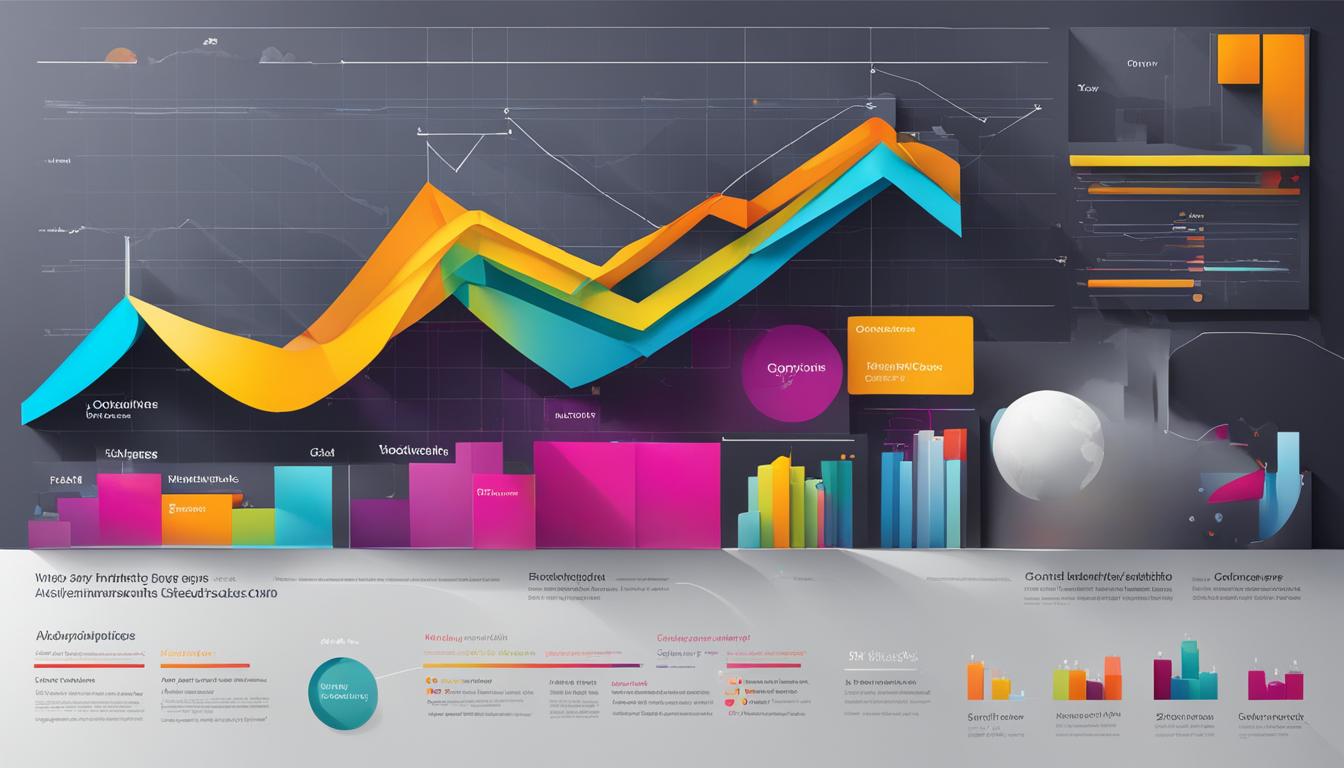Did you know that the leading marketing and sales professionals around the world employ a set of tactics that help them achieve exceptional results in their sales endeavors? These specialists have mastered the art of persuasion, honing their skills to connect with their target audience, showcase the benefits of their products, and motivate action. By understanding and implementing these proven tactics, you can greatly improve your sales and marketing efforts, attaining unprecedented success.
Key Takeaways:
- The best marketers and salespeople in the world utilize specific techniques to enhance their selling efforts.
- These techniques are designed to capture attention, emphasize benefits, and drive action.
- By understanding and implementing these techniques, you can achieve greater success in your sales and marketing endeavors.
- Focus on building relationships, prioritizing customer needs, and continuously refining your strategies.
- Stay updated with the latest trends and developments in the field of marketing and sales.
What are the Most Effective Sales Techniques?
In this section, we will delve into the most effective sales techniques utilized by top marketers and salespeople. By understanding and implementing these techniques, you can improve your sales performance and achieve better results in your business.
Sales Technique
First and foremost, it is crucial to master the art of sales technique. This involves utilizing various methods to capture the attention of potential customers, build rapport, and persuade them to take action. These techniques could include active listening, asking insightful questions, and effectively communicating the value proposition of your product or service.
Sales Methodology
Implementing a well-defined sales methodology is key to achieving consistent sales success. This involves adopting a structured approach to the sales process, from prospecting and qualifying leads to closing deals and nurturing customer relationships. Popular sales methodologies such as SPIN Selling, Solution Selling, and Consultative Selling can help guide your sales efforts.
Modern Sales Approaches
In today’s fast-paced business environment, it is essential to leverage modern sales approaches. This includes utilizing digital tools and technologies to streamline the sales process, such as CRM software, email marketing automation, and social selling techniques. Investing in sales enablement resources and staying up-to-date with the latest trends can give you a competitive edge.
Customer-Centric Selling
Adopting a customer-centric approach is crucial in today’s market. By putting your customers’ needs and preferences at the forefront of your sales strategy, you can build trust, establish long-lasting relationships, and drive customer loyalty. Understanding your customers’ pain points, delivering personalized solutions, and providing exceptional customer service are all key elements of customer-centric selling.
Effective Marketing Strategies
A strong partnership between marketing and sales is vital for success. By aligning your marketing strategies with your sales efforts, you can enhance lead generation, attract high-quality prospects, and optimize conversion rates. Utilizing inbound marketing techniques, content marketing, and targeted advertising campaigns can all contribute to a more effective sales process.
How to Improve Your Sales Prospecting Methods?
This section will focus on improving your sales prospecting methods. Sales prospecting is the process of identifying potential customers or clients for your business. By honing your prospecting techniques, you can uncover high-quality sales prospects, ultimately leading to increased sales opportunities and revenue growth.
One effective strategy to improve your sales prospecting methods is to optimize your targeting. Start by clearly defining your ideal customer profile. Identify the characteristics and demographics of your target audience and develop a comprehensive understanding of their pain points, needs, and challenges. This knowledge will enable you to tailor your sales efforts and approach each prospect with a personalized message.

Utilizing various tools and channels can also enhance your prospecting methods. Leverage social media platforms, online directories, and industry forums to identify potential sales prospects and engage with them. Use search engine optimization techniques to ensure your website and content rank highly in relevant searches, increasing your visibility to potential customers.
Building and maintaining a strong professional network can also be invaluable for sales prospecting. Attend industry events, join professional associations, and cultivate relationships with influencers and thought leaders in your field. These connections can provide valuable referrals and introductions to potential customers who meet your ideal customer profile.
Additionally, consider leveraging data analytics and CRM (Customer Relationship Management) tools to gain deeper insights into your prospecting efforts. Analyze prospect behavior patterns, monitor engagement metrics, and track lead conversion rates to identify trends and optimize your prospecting strategies.
Remember, effective sales prospecting requires persistence, resilience, and continuous improvement. Regularly review and refine your prospecting methods, incorporating feedback and learning from each interaction. By implementing these strategies and techniques, you can elevate your sales prospecting efforts and achieve greater success in your business.
Prospecting Techniques
In order to drive successful sales, it is crucial to implement effective prospecting techniques. In this section, we will explore various strategies that can support your sales efforts and help you attract and engage potential customers. By utilizing these techniques, you can increase your chances of converting prospects into loyal customers.
Sales Cycle
The sales cycle refers to the process that a prospect goes through, from the initial contact to the final purchase. Understanding the stages of the sales cycle can help you streamline your prospecting efforts and tailor your approach to each stage. By aligning your prospecting techniques with the different stages of the sales cycle, you can effectively guide prospects towards a successful conversion.
Building Trust with Prospects
Building trust is essential in any sales transaction. Prospects are more likely to make a purchase when they trust the salesperson and believe in the product or service being offered. To build trust, focus on establishing genuine connections with your prospects, providing valuable information, and demonstrating expertise in your field. By building trust, you can cultivate long-term relationships and increase sales opportunities.
Marketing Tactics
Marketing tactics play a vital role in prospecting and attracting potential customers. By leveraging effective marketing strategies, such as content marketing, social media advertising, and email campaigns, you can reach a wider audience and generate quality leads. Additionally, utilizing data-driven insights and personalization techniques can help you tailor your marketing efforts to the specific needs and preferences of your prospects.

| Prospecting Techniques | Sales Cycle | Building Trust with Prospects | Marketing Tactics |
|---|---|---|---|
| Identifying high-quality prospects | Understanding prospect needs | Establishing genuine connections | Content marketing |
| Engaging prospects through personalized outreach | Nurturing prospects through the decision-making process | Providing value and expertise | Social media advertising |
| Utilizing data-driven insights to target prospects | Facilitating seamless transitions between stages of the sales cycle | Addressing prospect concerns and objections | Email campaigns |
What Are the Best Sales Methodologies?
When it comes to achieving effective sales, having a well-defined sales methodology is essential. In this section, we will explore the best sales methodologies used by top marketers and salespeople to drive their success. By adopting these proven techniques, you can enhance your sales process and achieve better results for your business.
Effective Sales Strategies
An effective sales strategy is a crucial component of any successful sales methodology. It involves identifying the most efficient and impactful ways to reach and engage your target audience. By understanding your customers’ needs, pain points, and motivations, you can tailor your sales approach to resonate with them and provide valuable solutions.
One effective sales strategy is to adopt a customer-centric approach. This involves understanding your customers’ preferences, communication styles, and decision-making processes. By focusing on building relationships and delivering personalized experiences, you can create a sense of trust and loyalty, leading to higher conversion rates and customer satisfaction.
Sales Methods
Different sales methods can be used to guide your sales team in their interactions with potential customers. The choice of sales method will depend on the nature of your business, target audience, and the complexity of your products or services.
“The key to successful selling is to understand and adapt to the needs and preferences of your customers.”
Some popular sales methods include consultative selling, solution selling, and relationship selling. Consultative selling involves taking a collaborative approach with your customers, understanding their challenges, and offering tailored solutions. Solution selling focuses on presenting your product or service as the solution to your customers’ problems. Relationship selling emphasizes building long-term relationships based on trust and mutual value.
Sales Prospecting Techniques
Effective sales prospecting techniques are crucial for identifying and engaging with potential customers. By employing these techniques, you can enhance your lead generation efforts and increase your chances of closing deals.
Some effective sales prospecting techniques include networking, referral programs, and utilizing social media platforms. Networking allows you to connect with industry professionals and potential customers, expanding your reach and creating valuable business connections. Referral programs encourage satisfied customers to refer your business to others, leveraging the power of word-of-mouth marketing. Leveraging social media platforms can help you reach a larger audience and engage with potential customers in a more personalized and interactive way.
The Concept of 14 Selling and the Importance of a Sales Funnel
The concept of 14 selling refers to the idea that it takes an average of 14 touchpoints or interactions with a prospect before a sale is made. By understanding this concept, you can implement strategies to nurture leads and guide them through the sales process.
A well-defined sales funnel is vital for effective sales methodologies. It provides a visual representation of the different stages of the sales process, from initial contact to closing the sale. By mapping out your sales funnel and implementing appropriate strategies for each stage, you can streamline your sales process, increase efficiency, and maximize conversion rates.

| Sales Methodology | Key Characteristics |
|---|---|
| Consultative Selling | – Focuses on building relationships – Identifies customer needs through active listening – Offers tailored solutions |
| Solution Selling | – Presents product/service as a solution to customer’s problem – Emphasizes value and benefits – Addresses customer pain points |
| Relationship Selling | – Builds long-term relationships with customers – Focuses on trust and mutual value – Provides ongoing support and customer service |
How to Create an Effective Sales Pitch?
In this section, we will provide insights into creating an effective sales pitch. Crafting a compelling sales pitch is crucial for capturing the attention of your prospects and increasing your chances of closing deals. By incorporating key elements of a successful sales process, leveraging referrals, adopting different sales approaches, delivering impactful sales presentations, and building trust with your potential customers, you can create a persuasive sales pitch that drives results.
Let’s explore each aspect in detail:
Sales Process
The sales process refers to the step-by-step approach used to guide prospects through the buying journey. By understanding your customers’ needs, addressing their pain points, and demonstrating the value of your product or service, you can effectively move them closer to making a purchase. A well-defined sales process enables you to streamline your efforts, increase efficiency, and maximize conversion rates.
Referral
One of the most powerful tools in your sales arsenal is a referral. When satisfied customers refer your business to their network, it creates a sense of trust and credibility that can significantly impact your sales success. Actively seek referrals from happy customers and implement referral programs to incentivize and reward those who refer new business to you.
Sales Approach
Every prospect is different, and as a salesperson, it’s crucial to adapt your approach to suit their unique needs and preferences. Whether you adopt a consultative, solution-based, or relationship-driven approach, understanding your prospects’ motivations, challenges, and goals will enable you to tailor your sales pitch accordingly. Personalization and empathy play a vital role in building rapport with potential customers.
Sales Presentation
An effective sales presentation is carefully crafted to deliver compelling and persuasive messaging. Structure your presentation to highlight the unique selling points of your product or service, showcase real-life success stories, and address any objections or concerns your prospects may have. Visual aids, such as infographics or product demonstrations, can enhance the impact of your presentation and help prospects visualize the benefits of choosing your solution.
Build Trust
Trust is the foundation of any successful sales relationship. Building trust with your prospects requires authenticity, transparency, and consistent follow-through on promises. Demonstrate your expertise, showcase testimonials or case studies, and be responsive to your prospects’ needs throughout the buying process. By establishing trust, you position yourself as a credible and reliable partner, increasing the likelihood of closing sales.

By implementing these strategies and techniques, you can create a sales pitch that resonates with your audience, generates interest, and compels them to take action. Remember, effective sales pitches are rooted in understanding your customers, building trust, and delivering value. With a well-crafted pitch, you can influence buying decisions and drive business growth.
| Key Elements of an Effective Sales Pitch |
|---|
| Clear and concise messaging |
| Addressing customer pain points |
| Highlighting unique selling points |
| Providing social proof (testimonials, case studies, etc.) |
| Engaging visual aids (infographics, demos, etc.) |
| Personalization and empathy |
| Showcasing success stories |
| Building rapport and trust |
| Responsive and proactive communication |
What Marketing Tactics Can Help Improve Sales?
In order to improve sales, it is crucial to employ effective marketing tactics that align with your sales strategies. By leveraging the synergy between marketing and sales, understanding the needs and preferences of potential customers, utilizing inbound sales techniques, and building a strong marketing team, you can enhance your sales performance and drive better business outcomes.
One important aspect of improving sales is recognizing the correlation between marketing and sales. The marketing team plays a vital role in generating leads and creating brand awareness, which directly impacts the sales pipeline. By working closely together, marketing and sales can collaborate on strategies and campaigns that attract potential customers and facilitate the sales process.
Understanding your potential customers is key to tailoring your marketing tactics effectively. Conduct market research to identify your target audience, their demographics, preferences, and pain points. This information will enable you to create targeted marketing messages and campaigns that resonate with your potential customers, increasing the likelihood of conversion.
Inbound sales is another effective approach to improving sales. This strategy involves attracting potential customers through valuable content, engaging them with personalized experiences, and nurturing leads through each stage of the buyer’s journey. By implementing inbound sales techniques, such as content marketing, lead nurturing, and building strong customer relationships, you can attract and convert high-quality leads into loyal customers.
Building a competent and cohesive marketing team is essential for successful sales outcomes. The marketing team should consist of individuals with diverse skills and expertise, including content creators, digital marketers, social media experts, and data analysts. By leveraging the collective knowledge and expertise of your marketing team, you can develop and execute effective marketing campaigns that drive sales growth.

Marketing Tactics to Improve Sales
| Tactic | Description |
|---|---|
| Targeted Advertising | Create personalized ads that reach your specific target audience, increasing the chances of conversion. |
| Email Marketing | Develop strategic email campaigns to nurture leads, build relationships, and drive sales. |
| Social Media Engagement | Engage with potential customers on social media platforms to increase brand visibility and foster customer loyalty. |
| Content Marketing | Create valuable and informative content, such as blog posts, videos, and eBooks, to attract and engage potential customers. |
| Referral Programs | Incentivize existing customers to refer your products or services to others, expanding your customer base through word-of-mouth. |
| Data Analysis | Utilize data analytics tools to gain insights into customer behavior, identify trends, and optimize marketing efforts. |
By implementing these marketing tactics and leveraging the expertise of your marketing team, you can enhance your sales strategies and achieve better business outcomes. Remember to continuously monitor and refine your tactics based on data-driven insights to maximize their effectiveness and stay ahead in the competitive marketplace.
Conclusion
In conclusion, the techniques utilized by the best marketers and salespeople in the world are proven to be effective in driving sales and achieving success. By adopting and implementing these techniques in your own sales and marketing efforts, you can enhance your performance and achieve better results.
It is crucial to prioritize the needs of your customers throughout the sales process. By understanding their pain points and desires, you can tailor your approach to meet their specific needs. Building relationships based on trust and delivering value will ensure long-term customer satisfaction and loyalty.
Continuous refinement of your sales and marketing strategies is key to staying ahead in the competitive business landscape. Keep abreast of the latest trends and industry developments, and be open to experimenting with new ideas. By staying agile and adaptable, you can leverage the most effective sales techniques and marketing strategies to drive growth and outperform your competitors.
FAQ
What are the techniques the best marketers and salespeople in the world use when selling?
The best marketers and salespeople use various techniques to sell effectively. Some of these techniques include getting attention, emphasizing benefits, building value, and providing a clear call to action. They also focus on understanding their customers’ pain points and objections, and use effective closing, objection handling, and negotiation techniques to overcome them.
What are the most effective sales techniques?
The most effective sales techniques include utilizing a well-defined sales methodology, adopting modern sales approaches, implementing customer-centric selling strategies, and utilizing effective marketing techniques. By combining these techniques, salespeople can improve their sales process, attract their ideal customers, and achieve better results.
How can I improve my sales prospecting methods?
To improve your sales prospecting methods, it is important to identify and engage high-quality sales prospects. This can be done by understanding the sales cycle, building trust with prospects, and using effective marketing tactics. By utilizing these techniques, you can increase your chances of converting prospects into loyal customers.
What are some prospecting techniques that can help improve my sales efforts?
Some prospecting techniques that can help improve your sales efforts include understanding the sales cycle, building trust with prospects, and employing effective marketing tactics. By implementing these techniques, you can attract and engage potential customers, increasing your chances of converting them into paying customers.
What are the best sales methodologies?
The best sales methodologies include utilizing an effective sales strategy, adopting a proven sales method, implementing successful sales prospecting techniques, understanding the concept of 14 selling, and optimizing the sales funnel. By incorporating these methodologies, you can enhance your sales process and achieve better results.
How can I create an effective sales pitch?
To create an effective sales pitch, it is important to understand the key elements of a successful sales process. This includes building trust with your prospects, utilizing referral strategies, adopting different sales approaches, delivering impactful sales presentations, and emphasizing the benefits of your product or service. By crafting an impactful sales pitch, you can capture the attention of your prospects and increase your chances of closing deals.
What marketing tactics can help improve sales?
To improve sales, it is important to align marketing and sales efforts. This can be achieved by understanding potential customers, implementing effective sales strategies, utilizing inbound sales techniques, and having a strong marketing team. By implementing these marketing tactics, you can support your sales efforts and drive better business outcomes.










